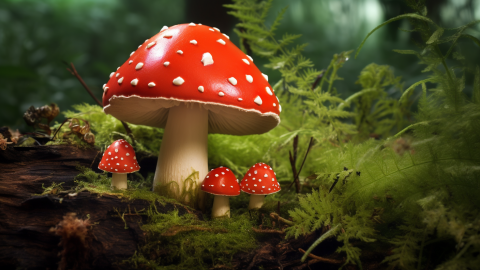Why does eating poisonous mushrooms cause hallucinations?
Hallucinations caused by eating poisonous mushrooms are primarily due to psychoactive components in the mushrooms acting on the nervous system. These include psilocybin affecting neurotransmitters, muscarine disrupting nerve signals, gyromitrin stimulating the brain, orellanine damaging nerve cells, and amatoxins indirectly impacting neurological function. A detailed analysis is as follows:

1. Psilocybin-containing mushrooms affect neurotransmitters: Some toxic mushrooms contain psilocybin, which is converted into active substances after entering the human body. These substances bind to serotonin receptors in the brain, interfering with normal serotonin transmission, disrupting neural signaling balance, causing abnormalities in perception, and thereby triggering hallucinations.
2. Muscarine-containing mushrooms disrupt nerve signals: Certain poisonous mushrooms contain muscarine, which mimics the action of acetylcholine and excessively activates cholinergic neural pathways. This leads to disordered transmission of nerve signals in the brain, impairing the functions of visual and auditory centers, resulting in false sensory perceptions.
3. Gyromitrin-containing mushrooms stimulate the brain: Gyromitrin is present in some toxic mushrooms. After ingestion, it is metabolized into toxic compounds that directly stimulate the cerebral cortex, particularly affecting brain regions responsible for perception and cognition. This causes abnormal information processing in the brain and induces hallucinations.
4. Orellanine destroys nerve cells: Orellanine damages nerve cells in the brain and spinal cord, disrupting the normal structure of neural tissues and impairing the reception and transmission of nerve signals. This leads to dysfunction of the sensory system and results in hallucinatory symptoms.
5. Amatoxins indirectly affect neurological function: Amatoxins primarily damage the liver and kidneys. However, metabolic disturbances caused by organ damage can indirectly impact the nervous system, leading to abnormal oxygen and energy supply to the brain, interfering with neural function, and thus indirectly inducing hallucinations.
To prevent poisoning, avoid picking and consuming wild mushrooms. Never eat any mushroom if you cannot confidently identify its species. If you accidentally ingest a toxic mushroom and experience symptoms such as hallucinations or vomiting, seek immediate medical attention without delay to prevent worsening health consequences.





